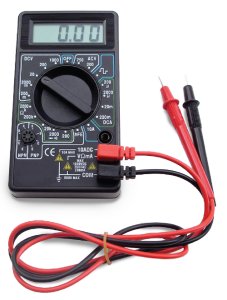Troubleshooting Best Practices for Data Acquisition Systems
by Jason Ritter | Updated: 07/08/2015 | Comments: 0
Are your current troubleshooting methods not as helpful as you’d like them to be? This article discusses a number of troubleshooting best practices you can use, which may help you determine the source of the problem and resume your data collection more quickly.

When I first started working at Campbell Scientific, one of our more seasoned application engineers had a sign near his desk that asked a simple question: "Is your data logger turned on?" I inquired about the sign, and the application engineer (AE) shared the story with me.
Several years before, the AE had received an urgent call from a customer who was having trouble communicating with her data logger. She was working in a remote area and had left the data logger to run unattended for a week. When she returned to collect the data, she couldn't establish communication between her data logger and a laptop. The AE helped her to perform all of the standard troubleshooting steps for a communications issue, but nothing helped, and the customer became increasingly frustrated. Finally, in desperation, the AE asked, “Is your data logger turned on?” There was a short pause, and then the embarrassed customer hung up the phone without further discussion.
Although the customer was embarrassed, she didn't need to be. Forgetting to check something as basic as whether there is power to the system is a common mistake—even among those of us who work with Campbell Scientific gear every day. The AE put up that sign to remind him to always start with the basics when troubleshooting.
Understanding Troubleshooting
Troubleshooting is simply the process used to find the source of a problem and then employ a solution to that problem. When you are faced with a complex system involving measurement, peripheral, and communications hardware; software; power supplies; and sensors, the sheer number of things that can possibly go wrong may seem overwhelming. However, you can eliminate many possible problems by using a few tools and some simple tests.
Tools and Tests

You can perform many troubleshooting tests with a simple digital multimeter. A good multimeter provides independent verification of the voltages the data logger is measuring. This device allows you to make an independent check of expected voltages and verify electrical continuity between connection points.
A digital multimeter is just one tool for your troubleshooting toolbox. The essential tools to troubleshoot a Campbell Scientific data acquisition system include the following:
- Digital multimeter
- Small (2.5 mm) flat-bladed screwdriver
- Wire strippers
- Data logger keyboard/display or computer for communicating with the data logger
Note: You may need a Phillips #1 screwdriver to remove some components from their mountings or to remove their covers.
|
Recommended for You: Read our "Tips and Tricks: What's in Your Toolbox?" article. |
You can use these tools to conduct common troubleshooting tests such as the following:
- Measuring voltage
- Testing for continuity
- Swapping locations of sensor connections
- Changing the environment the sensor experiences to force a change of reading
In many cases, it’s helpful if you can think of a way to independently verify the right answer. For example, if a temperature sensor doesn't seem to be giving correct readings, you could do a simple test by putting it in ice water, which is independently known to have a temperature of 0°C.
Asking the Right Question

While tools and tests aid your troubleshooting efforts, ultimately, successful troubleshooting always depends on asking and answering the right question. You can't find the right answer without finding the right question first. The right question is the one that uncovers a problem.
It's normal to approach a problem with a set of assumptions. To find the problem that must be solved, try asking yourself a list of questions that begin with “Is my assumption correct that . . . ?” You can use your answers in this way:
- When the answer is “no,” you have identified at least one right question, and you can take corrective action. In other words, test each assumption until one or more tests fail.
- When the answer is “yes,” it must be supported by answering this follow-up question: “How do I know that . . . is true?” Each “yes” answer requires a simple test with an unambiguous answer.
|
For example:
|
Understanding the Measurement Process
To systematically find the right question, it's important to have a basic understanding of what is being measured and how that measurement is processed. Typically, the process looks like this:
- Some environmental parameter is converted to an electrical signal by a sensor.
- That electrical signal is measured and digitized by a data logger.
- The measurement is processed statistically and stored in data logger memory.
- The measurement is eventually transferred to a computer for analysis and display.
It's common that you might not find a problem with the measurement until you take a close look at the data on a computer and see a measurement number that doesn't make sense. That's often the point where troubleshooting begins. You’ll find that the process goes much smoother when you take the time to understand how the sensor responds to environmental changes and what kind of electrical output it sends to the data logger.
Horses, Not Zebras
A popular medical proverb says, “When you hear hoofbeats, think of horses, not zebras,” meaning that when faced with diagnosing a problem, it's best to look first for expected causes rather than exotic ones. When you are dealing with instrumentation problems, the short list of expected causes includes the following:
- Physical damage to electronic components
- Lack of electrical power
- Problems with the electrical connections between system components
- Errors in software settings or logic
With a little bit of practice, you can develop your own method for systematically testing the more common causes of problems.
Common Problems
When you troubleshoot your measurement equipment, keep in mind these common problems:
- Power issues—bad battery, bad connection, ac outlet not energized, battery capacity too small
- Wiring issues—loose or damaged wires, wires connected to wrong terminals
- Programming issues—data logger program not matching the physical wiring, wrong settings in program instructions, logical statements that never evaluate as true
Remember these common problems when you troubleshoot your communications equipment:
- Power issues—communications hardware not receiving power
- Configuration issues—settings in the firmware or communications software, account settings
- System issues—antenna size, obstacles to line-of-sight, radio interference, firewalls, administrative rights
You can isolate each of these problems and test your assumptions with simple procedures. Each time you find an assumption that doesn't hold up, you have asked at least one right question and can start moving toward a solution.
Stepping Back
Sometimes it's good to take a break from testing and summarize what you have learned so far. Start with the question "What do I know for sure?" and list what you have learned from your simple tests. This is especially helpful if you have been trying a lot of different tests and you start to lose track of the results. Taking a step back to look at the big picture often reveals a basic assumption that you haven't considered testing yet, and that may be the one that is the source of the problem.
“Is your data logger turned on?” is a simple question, but the answer may save you time and frustration.
Do you have a favorite troubleshooting story or best-practice tip? Feel free to share it.















 Jason Ritter was a Senior Support and Implementation Engineer at Campbell Scientific, Inc. He worked with customers to help them make the best measurement possible. Jason was a longtime fan of Campbell Scientific, having been a customer for ten years before joining the company as an application engineer. He also held the positions of soil scientist, soils product manager, soils market manager, and product group manager.
Jason Ritter was a Senior Support and Implementation Engineer at Campbell Scientific, Inc. He worked with customers to help them make the best measurement possible. Jason was a longtime fan of Campbell Scientific, having been a customer for ten years before joining the company as an application engineer. He also held the positions of soil scientist, soils product manager, soils market manager, and product group manager.
Comments
Please log in or register to comment.